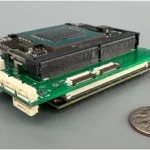
Delays in the test flight certification of the United Launch Alliance (ULA) Vulcan rocket's Centaur V upper stage will not result in any extra launches for SpaceX for the U.S. Space Force (USSF) National Security Space Launch (NSSL) program, Space Force's Space Systems Command (SSC) said on Sept. 8. ULA is a partnership between Boeing [BA] and Lockheed Martin [LMT]. In June, SSC assigned 12 NSSL missions to SpaceX and ULA–six for each provider–under the fiscal 2023 NSSL Phase 2…














